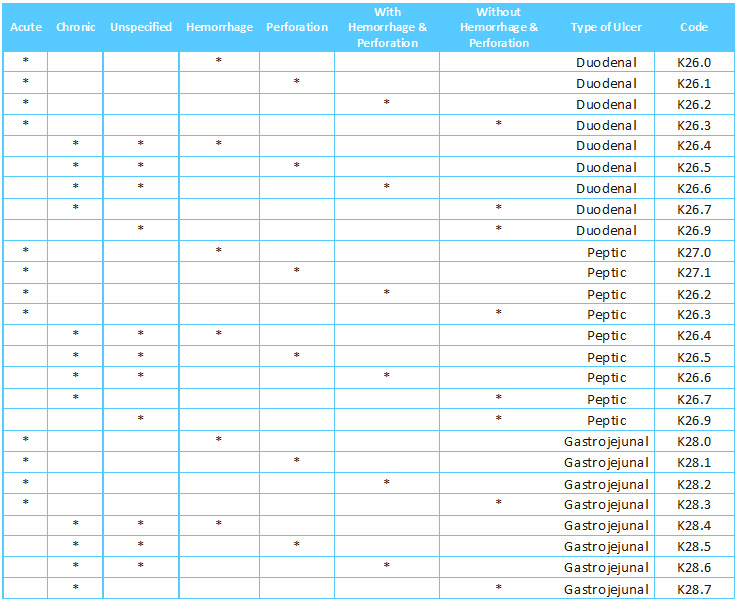How To Code For Ulcers According To ICD-10 Guidelines

With ICD-10, reporting for type, occurrence site, and complication has dramatically increased coding complexity. There are codes ranging from problems in relationship with in-laws (Z63.1) to being pecked by a chicken (W61.33) to being bitten by a sea lion (W56.11)!
Ulcer is one of the most frequently reported diagnosis codes in gastroenterology. However, with the advent of ICD-10, coding for the simple diagnosis has become complicated for even the most experienced doctors.
To make your life a little easier, we compiled a list of accurate coding guidelines for ulcers that you could refer to for your next case.
Ulcers are broadly classified based on the organ they are present.
1) Gastric ulcer (K25)
2) Duodenal ulcer (K26)
3) Peptic ulcer (K27)
4) Gastrojejunal ulcer (K28)
Each type of ulcer is further classified into acute or chronic. If the nature of ulcer cannot be determined, an “unspecified” code may be used.
Coding now goes up to the 4th level (or the fourth digit of ICD-10 code) of specificity. Each type of ulcer is coded with reference to the complications associated with it. For example, the code used for Acute gastric ulcer with hemorrhage would be K25.0
The ICD-10 CM manual also instructs the use additional codes if the patient is diagnosed with alcohol abuse and dependence.
F10 is the ICD-10 code for alcohol related disorders which is classified further into alcohol abuse (F10.1), alcohol dependence (F10.2), alcohol use, unspecified (F10.9). The F10 code can be further specified by the use additional codes. For example, blood alcohol level measurement is Y90.
Let’s understand this using a patient scenario:
Joan, age 36 years, presented with abdominal pain, nausea, vomiting and melena. She was scheduled for EGD after unsatisfactory PPI treatment. EGD revealed acute duodenal ulcer which was bleeding along with perforations. She consumes alcohol every day and shows withdrawal delirium. Her blood alcohol levels were 72 mg/100ml.
The coding for this scenario would be as follows:
Primary code: K26.2 (because the type of ulcer is duodenal and it is acute with hemorrhage and perforation)
Secondary code: F10.231 (because she exhibits alcohol dependence with withdrawal delirium)
Tertiary code: Y90.3 (because of the range of her blood alcohol level is 60-79 mg/100 ml)
This is how you think in an ICD-10 world. More specifically.
Below are coding guidelines in a tabulated format:
How to use this table:
The (*) mark specifies the nature of the condition.
For example, if an ulcer is duodenal, is acute and hemorrhage is present – the code to use would be K26.0
Another example, if an ulcer is peptic, is chronic/unspecified and hemorrhage is present – the code to use would be K26.4
Correct coding practices are the backbone for clean claims. Submitting clean claims with high first-pass ratio bring predictability in reimbursements. Pay attention to the levels of specificity that ICD-10 demands.
Have you come across any unique coding scenarios? Let me know in the comments below.
_
By Sandeep Paranjape, NextServices
Related:
[FREE GUIDE] How to bill accurate codes for endoscopy procedures
Adhere to ICD-10 coding guidelines now [avoid payment disruptions]
